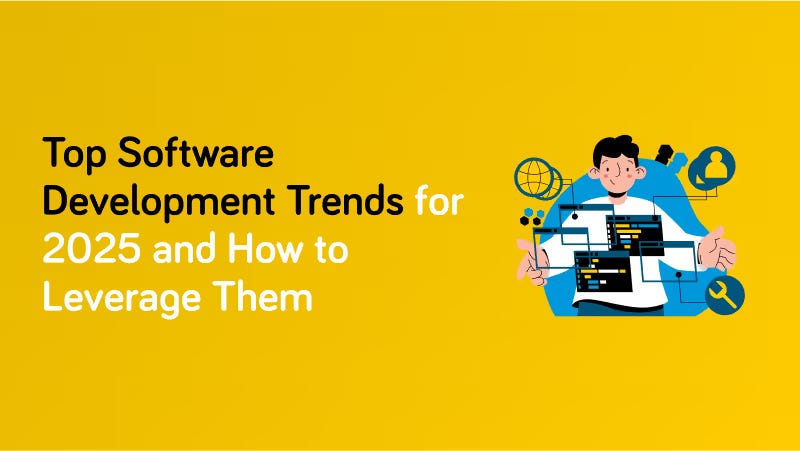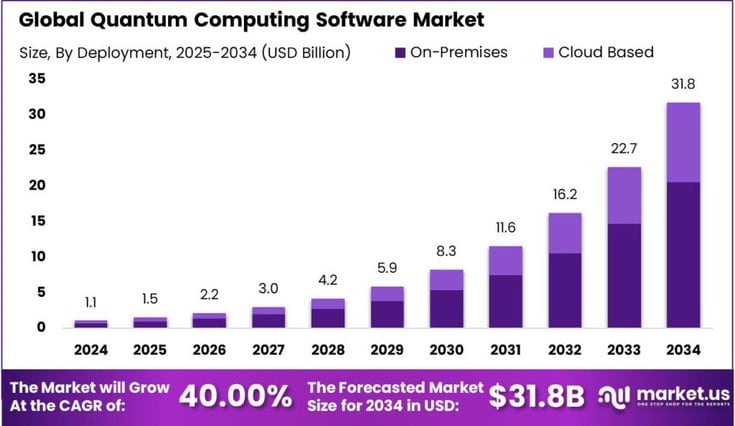Leveraging Quantum Computing for Efficient Software Development in 2024
Quantum computing has rapidly transitioned from theoretical research to practical application, making significant waves in the world of software development. As of 2024, quantum technologies are being integrated into mainstream development pipelines, leading to dramatic improvements in efficiency, performance, and innovation. The latest research shows a 13% increase in quantum technology (QT) patents in 2024, signaling accelerated adoption and investment. Leading companies have secured oversubscribed funding rounds—like the $27M AWS Gen AI Accelerator class—and are now deploying hybrid quantum-classical solutions that redefine the software development landscape.
This comprehensive guide will provide a hands-on exploration of how quantum computing is leveraged for efficient software development in 2024. We'll cover the latest trends, actionable best practices, real-world case studies, and extensive code examples using leading quantum frameworks. Whether you're a software developer, IT manager, or quantum computing enthusiast, you'll gain practical insights and the tools needed to harness this emerging technology.
Let's dive deep into the quantum revolution and uncover how it drives efficiency, scalability, and innovation in software development.

The State of Quantum Computing in Software Development: 2024 Trends and Statistics
Quantum computing, once confined to academic circles, is now a driving force behind software innovation. According to Dwivedi et al., there has been a notable 13% year-over-year increase in quantum technology patents in 2024, reflecting a surge in research, investment, and real-world deployment. Hybrid quantum-classical algorithms and improved qubit fidelity are among the leading trends, with companies leveraging quantum machine learning (QML), optimization, and simulation for a competitive edge.
Industry analysts predict a Compound Annual Growth Rate (CAGR) of 40% for the quantum computing software market through 2025. Major cloud providers are rolling out quantum resources, and startups are attracting unprecedented venture funding. This section explores these trends in detail and sets the stage for practical implementation.

- 13% increase in quantum technology patents (2024)
- Quantum software market CAGR of 40% through 2025
- Hybrid quantum-classical models deployed in production pipelines
- Major cloud providers (AWS, Azure, Google) offering quantum resources
- Quantum Machine Learning and optimization as top application areas
- $27M+ funding rounds for quantum startups in early 2024
"Quantum computing is no longer a theoretical playground; it's a production-ready technology driving efficiency and scalability in software development." – Industry Analyst"
Quantum Software Stack: Key Components and Setup
To effectively leverage quantum computing, developers need to understand the quantum software stack—from hardware access to high-level programming frameworks. Leading platforms include IBM Qiskit, Google Cirq, and Amazon Braket SDK. Let’s set up a basic quantum development environment using Qiskit, one of the most widely adopted open-source frameworks.
# Install Qiskit via pip
pip install qiskit# qiskit_config.yaml
[default]
backend = 'ibmq_qasm_simulator'
api_token = '<YOUR_IBM_Q_API_TOKEN>'from qiskit import QuantumCircuit, execute, Aer
from qiskit.visualization import plot_histogram
# Create a simple quantum circuit with 2 qubits
qc = QuantumCircuit(2)
qc.h(0) # Hadamard gate on qubit 0
qc.cx(0, 1) # CNOT gate between qubits 0 and 1
# Execute on simulator
simulator = Aer.get_backend('qasm_simulator')
job = execute(qc, simulator, shots=1024)
result = job.result()
counts = result.get_counts(qc)
print(counts)# Command to visualize the circuit in Jupyter Notebook
qc.draw('mpl')# Save configuration for Amazon Braket (AWS)
[default]
aws_access_key_id = <YOUR_AWS_ACCESS_KEY_ID>
aws_secret_access_key = <YOUR_AWS_SECRET_ACCESS_KEY>
region = us-west-2Building Your First Quantum Application: From Classical to Hybrid
A common first step in quantum development is building a simple quantum circuit, then progressively integrating classical pre- and post-processing logic. Hybrid quantum-classical workflows are the backbone of efficient quantum software development in 2024, enabling developers to offload computationally intensive tasks to quantum processors while retaining classical control flow.
Let’s walk through building a hybrid quantum-classical algorithm for solving a basic optimization problem.

import numpy as np
from qiskit import Aer, execute, QuantumCircuit
from qiskit.circuit.library import TwoLocal
from qiskit.algorithms import VQE
from qiskit.opflow import Z, I, X, StateFn, PauliSumOp
from qiskit.utils import QuantumInstance
from qiskit.algorithms.optimizers import COBYLA
# Define a simple Hamiltonian for optimization
hamiltonian = PauliSumOp.from_list([('ZI', 1), ('IZ', 1), ('ZZ', 1)])
# Create a variational form (ansatz)
ansatz = TwoLocal(2, ['ry', 'rz'], 'cz', reps=2)
# Set up VQE algorithm
optimizer = COBYLA(maxiter=100)
backend = Aer.get_backend('statevector_simulator')
quantum_instance = QuantumInstance(backend)
vqe = VQE(ansatz, optimizer=optimizer, quantum_instance=quantum_instance)
# Run VQE to minimize the expectation value of the Hamiltonian
result = vqe.compute_minimum_eigenvalue(hamiltonian)
print("Minimum eigenvalue:", result.eigenvalue.real)# Classical pre-processing: normalizing input data
def normalize(data):
min_val, max_val = np.min(data), np.max(data)
return (data - min_val) / (max_val - min_val)
samples = np.array([5, 10, 15, 20])
normalized_samples = normalize(samples)
print(normalized_samples)# Hybrid workflow: combining classical and quantum steps
def hybrid_optimizer(classical_data):
norm_data = normalize(classical_data)
# Use norm_data in quantum ansatz parameterization
# ... (see previous VQE example)
return result.eigenvalue.real
hybrid_result = hybrid_optimizer(samples)
print("Hybrid optimizer result:", hybrid_result)# Error handling: check backend availability
try:
backend = Aer.get_backend('statevector_simulator')
except Exception as e:
print(f"Error: {e}. Please ensure Qiskit and Aer are installed correctly.")# Test quantum circuit with mock data
test_data = np.random.randint(0, 20, 4)
print("Test input:", test_data)
print("Hybrid optimizer test result:", hybrid_optimizer(test_data))Quantum Machine Learning: Accelerating AI with Quantum-Classical Synergy
Quantum Machine Learning (QML) is a rapidly growing field, with 2024 seeing major breakthroughs in hybrid algorithms. QML leverages quantum circuits to encode and process data, accelerating classical machine learning tasks such as classification, clustering, and optimization. This section will demonstrate a quantum-enhanced classifier using Qiskit’s `qiskit-machine-learning` extension and provide step-by-step code for integrating quantum kernels into a classical scikit-learn pipeline.

# Install required packages
pip install qiskit-machine-learning scikit-learnfrom qiskit_machine_learning.kernels import QuantumKernel
from qiskit import QuantumCircuit, Aer
from sklearn.svm import SVC
from sklearn.datasets import make_classification
from sklearn.model_selection import train_test_split
from sklearn.metrics import accuracy_score
# Generate synthetic dataset
X, y = make_classification(n_samples=100, n_features=2, n_informative=2, n_redundant=0, random_state=42)
X_train, X_test, y_train, y_test = train_test_split(X, y, test_size=0.2, random_state=42)
# Create a quantum circuit for kernel
def feature_map(x):
qc = QuantumCircuit(2)
qc.h(0)
qc.ry(x[0], 0)
qc.ry(x[1], 1)
qc.cx(0, 1)
return qc
# Define quantum kernel
quantum_kernel = QuantumKernel(feature_map=feature_map, quantum_instance=Aer.get_backend('statevector_simulator'))# Integrate quantum kernel with scikit-learn SVM
svc = SVC(kernel=quantum_kernel.evaluate)
svc.fit(X_train, y_train)
y_pred = svc.predict(X_test)
print("Quantum SVM Accuracy:", accuracy_score(y_test, y_pred))# Compare with classical classifier
from sklearn.svm import LinearSVC
lin_svc = LinearSVC(max_iter=10000)
lin_svc.fit(X_train, y_train)
y_pred_classical = lin_svc.predict(X_test)
print("Classical SVM Accuracy:", accuracy_score(y_test, y_pred_classical))# Visualize decision boundaries (inline in Jupyter)
import matplotlib.pyplot as plt
import numpy as np
xx, yy = np.meshgrid(np.linspace(X[:,0].min(), X[:,0].max(), 100), np.linspace(X[:,1].min(), X[:,1].max(), 100))
Z = svc.predict(np.c_[xx.ravel(), yy.ravel()])
Z = Z.reshape(xx.shape)
plt.contourf(xx, yy, Z, alpha=0.4)
plt.scatter(X[:,0], X[:,1], c=y)
plt.title("Quantum SVM Decision Boundary")
plt.show()Deploying Quantum Workflows in Production Environments
Moving from experimentation to production presents unique challenges: orchestration, error mitigation, and integration with existing CI/CD pipelines. In 2024, cloud-based quantum services (AWS Braket, Azure Quantum, Google Quantum AI) enable seamless deployment and scaling. This section presents a practical deployment workflow using Amazon Braket SDK, including configuration, job submission, and monitoring.

# Install Amazon Braket SDK
pip install amazon-braket-sdkfrom braket.aws import AwsDevice, AwsQuantumTask
from braket.circuits import Circuit
import time
# Choose a quantum device (simulator or real hardware)
device = AwsDevice("arn:aws:braket:::device/quantum-simulator/amazon/sv1")
# Build a simple quantum circuit
circuit = Circuit().h(0).cnot(0, 1)
# Submit quantum task
task = device.run(circuit, shots=1000)
# Wait for completion and retrieve results
while not task.state() == 'COMPLETED':
print("Waiting for job to complete...")
time.sleep(5)
result = task.result()
print("Measurement counts:", result.measurement_counts)# .braket/config
[default]
aws_access_key_id = <YOUR_AWS_ACCESS_KEY_ID>
aws_secret_access_key = <YOUR_AWS_SECRET_ACCESS_KEY>
region = us-west-2# Integrate quantum workflow in CI/CD pipeline (GitHub Actions example)
name: Quantum CI Pipeline
on: [push]
jobs:
build:
runs-on: ubuntu-latest
steps:
- uses: actions/checkout@v2
- name: Set up Python
uses: actions/setup-python@v2
with:
python-version: '3.10'
- name: Install dependencies
run: |
pip install qiskit amazon-braket-sdk
- name: Run tests
run: |
python -m unittest discover tests/# Error handling: monitor quantum job states
def check_task_status(task):
try:
state = task.state()
if state == 'FAILED':
print("Quantum job failed. Check logs for details.")
elif state == 'COMPLETED':
print("Quantum job completed successfully.")
else:
print(f"Quantum job state: {state}")
except Exception as e:
print(f"Error monitoring quantum job: {e}")Performance Optimization and Error Mitigation in Quantum Software
Quantum computers are prone to noise and error, especially on today’s NISQ (Noisy Intermediate-Scale Quantum) hardware. Efficient software development requires robust error mitigation strategies and performance tuning, such as error correction codes, transpilation for optimal gate depth, and hybrid error-aware algorithms. Here, we demonstrate practical error mitigation and optimization techniques using Qiskit’s transpiler and noise models.

# Simulate noise model
from qiskit.providers.aer.noise import NoiseModel, depolarizing_error
from qiskit import Aer, execute, QuantumCircuit
noise_model = NoiseModel()
noise_model.add_all_qubit_quantum_error(depolarizing_error(0.01, 1), ['u1', 'u2', 'u3'])
qc = QuantumCircuit(2)
qc.h(0)
qc.cx(0, 1)
simulator = Aer.get_backend('qasm_simulator')
job = execute(qc, simulator, noise_model=noise_model, shots=1024)
result = job.result()
print(result.get_counts())# Optimize quantum circuit for hardware
from qiskit.transpiler import PassManager
from qiskit.transpiler.passes import Optimize1qGates
optimized_qc = qc.copy()
pass_manager = PassManager(Optimize1qGates())
optimized_qc = pass_manager.run(optimized_qc)
print(optimized_qc)# Error mitigation: zero-noise extrapolation
from qiskit.ignis.mitigation.measurement import complete_meas_cal, CompleteMeasFitter
cal_circuits, state_labels = complete_meas_cal(qubit_list=[0,1], circlabel='mcal')
cal_job = execute(cal_circuits, simulator, shots=1024)
cal_results = cal_job.result()
meas_fitter = CompleteMeasFitter(cal_results, state_labels)
mitigated_counts = meas_fitter.filter.apply(result.get_counts(qc))
print("Mitigated counts:", mitigated_counts)# Debugging: visualize errors in circuit
qc.measure_all()
print(qc.draw())# Benchmark quantum circuit execution time
import time
start = time.time()
job = execute(qc, simulator, shots=1024)
result = job.result()
end = time.time()
print(f"Execution time: {end - start:.2f} seconds")Security and Compliance in Quantum Software Development
Security is paramount in quantum software development, especially as quantum algorithms threaten classical encryption schemes. While quantum computers promise breakthroughs, they also necessitate new approaches to cryptography, secure access, and regulatory compliance. This section highlights best practices for securing quantum software pipelines and introduces post-quantum cryptography tools.

# Example: Post-quantum cryptography with pyca/cryptography
pip install cryptographyfrom cryptography.hazmat.primitives.asymmetric import rsa
from cryptography.hazmat.primitives import serialization
# Generate secure RSA key (use post-quantum alternatives in future)
private_key = rsa.generate_private_key(public_exponent=65537, key_size=4096)
private_bytes = private_key.private_bytes(
encoding=serialization.Encoding.PEM,
format=serialization.PrivateFormat.TraditionalOpenSSL,
encryption_algorithm=serialization.NoEncryption()
)
print(private_bytes.decode('utf-8'))# Secure your quantum API keys (environment variables)
import os
os.environ['AWS_ACCESS_KEY_ID'] = '<YOUR_AWS_ACCESS_KEY_ID>'
os.environ['AWS_SECRET_ACCESS_KEY'] = '<YOUR_AWS_SECRET_ACCESS_KEY>'# Example configuration file for secure quantum access
[security]
api_key_env = 'AWS_ACCESS_KEY_ID'
api_secret_env = 'AWS_SECRET_ACCESS_KEY'
use_post_quantum_crypto = true# Validate quantum job permissions
from braket.aws import AwsSession
session = AwsSession()
if not session.profile:
print("Warning: AWS session profile not set. Check your credentials.")Testing, Validation, and Debugging Quantum Software
Testing and validation are critical to robust quantum software. Unlike classical applications, quantum programs require probabilistic validation and noise-aware testing. Best practices include using quantum simulators for deterministic tests, unit-testing hybrid algorithms, and integrating continuous validation in CI/CD workflows.
# Unit test for quantum circuit
import unittest
from qiskit import QuantumCircuit, Aer, execute
class TestQuantumCircuit(unittest.TestCase):
def test_entanglement(self):
qc = QuantumCircuit(2)
qc.h(0)
qc.cx(0, 1)
simulator = Aer.get_backend('qasm_simulator')
job = execute(qc, simulator, shots=1000)
result = job.result()
counts = result.get_counts()
self.assertTrue('00' in counts and '11' in counts)
if __name__ == '__main__':
unittest.main()# Integration test: hybrid quantum-classical pipeline
def test_hybrid_pipeline():
data = np.array([1, 2, 3, 4])
result = hybrid_optimizer(data)
assert isinstance(result, float), "Result should be a float."
test_hybrid_pipeline()# Continuous validation in CI pipeline (GitHub Actions snippet)
name: Quantum Test Pipeline
on: [push]
jobs:
test:
runs-on: ubuntu-latest
steps:
- uses: actions/checkout@v2
- name: Set up Python
uses: actions/setup-python@v2
with:
python-version: '3.10'
- name: Install dependencies
run: |
pip install qiskit
- name: Run tests
run: |
python -m unittest discover tests/# Debugging: print quantum statevector
from qiskit import Aer, execute
backend = Aer.get_backend('statevector_simulator')
job = execute(qc, backend)
statevector = job.result().get_statevector()
print("Quantum statevector:", statevector)# Visualize quantum circuit for validation
qc.draw('mpl')Conclusion: Actionable Strategies for Quantum-Driven Software Efficiency
Quantum computing is reshaping software development in 2024, driving new levels of efficiency, scalability, and innovation. By adopting hybrid quantum-classical algorithms, integrating robust error mitigation, and following security best practices, developers and organizations can position themselves at the forefront of this technological revolution. The 13% increase in QT patents and explosive market growth underscore the urgency to upskill and experiment with quantum technologies now.
To get started:
- Set up a quantum development environment using Qiskit, Cirq, or Amazon Braket
- Build and deploy hybrid quantum-classical applications for optimization and AI
- Adopt best practices for testing, validation, and error mitigation
- Monitor industry trends and regulatory changes in quantum security
- Join quantum developer communities and contribute to open-source projects

- Set up your quantum toolkit and experiment with sample circuits
- Integrate quantum solutions with classical workflows
- Prioritize security and compliance as quantum adoption grows
- Engage with quantum developer communities for support and collaboration
Thanks for reading!